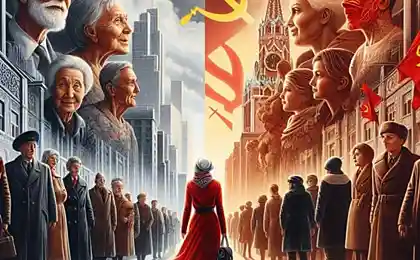275
Generational conflict: the root causes and manifestations of the generation gap of the XX century

Five generations of the XX century in one frame: from the Silent generation to Generation Z
“Youth today loves luxury, she is poorly educated, she mocks the authorities and does not respect the elderly” – this phrase is often attributed to Socrates, who lived in the fifth century BC. Regardless of the true authorship, it testifies to the antiquity of the phenomenon of conflict of generations. However, it was the twentieth century with its unprecedented social, technological and cultural transformations that brought this conflict to a qualitatively new level.
In modern society, the gap between the worldviews of representatives of different generations has reached such a depth that it sometimes seems insurmountable. To understand the nature of this phenomenon, it is necessary to delve into the analysis of each generation of the twentieth century, their formative events and basic values. In our review article on the generations of XX-XXI centuries, we have considered in detail the characteristics of each generation. Now it is time to analyze the origins and manifestations of the conflicts between them.
Theoretical Foundations of Generational Conflict
The term “generational conflict” was first explicitly formulated by American sociologist Lewis Foyer in 1969. The most structured explanation came from economist Neil Hove and historian William Strauss, who created the “generational theory” in 1991. According to their concept, approximately every 20-25 years, a new generation is formed with a unique set of values determined by the socio-economic and political conditions of the period of growing up.
The key thesis
The generational conflict of the twentieth century is unique in that, for the first time in human history, the rate of social, technological and cultural change has exceeded the rate of generational change. This created a situation in which the experience of older generations was partially or completely devalued in the eyes of younger generations due to radically changed living conditions.
The Great Generation and the Silent Generation: The Conflict of Survival and Stability
The Great Generation (1901-1927) and the Silent Generation (1928-1945) were formed in an era of global upheaval: two world wars, the Great Depression, revolutionary movements. The conflict between the two was primarily about risk and change. The great generation, hardened by hardship and struggle, showed great determination and readiness for radical transformations. The silent generation, growing up among the ruins of the established world order, sought primarily stability and security.
Historical context of conflict
In the USSR, the contradictions between the Great and Silent Generations manifested themselves during the Khrushchev “thaw”. Elders who survived the revolution and Stalinist repression were wary of regime liberalization, while younger ones enthusiastically supported limited reforms, seeing them as a chance to normalize life after the era of terror.
Baby Boomers and Generation X: The Rupture of Idealism and Pragmatism

The Contrast of Worldviews: Baby Boomer Idealism vs. Generation X Pragmatism
The most dramatic gap occurred between the Baby Boomers (1946-1964) and Generation X (1965-1980). Baby boomers, who grew up in the post-war economic boom, inherited a belief in stable jobs and social institutions from their parents, but challenged conservative values by creating the counterculture of the 1960s. Generation X was formed during the economic turbulence of the 1970s and the neoliberal reforms of the 1980s. By the time they entered adulthood, many of the welfare state’s promises had been unfulfilled, generating a deep skepticism of baby boomers’ idealistic aspirations.
Cultural manifestations of conflict
The contrast between generations is evident in music. If the rock music of baby boomers was imbued with ideas of social transformation and building a better world (from The Beatles to Pink Floyd), then grunge and alternative rock of Generation X (Nirvana, Pearl Jam) expressed existential anxiety and distrust of loud slogans. “It is better to burn than to fade away.” Kurt Cobain became a manifesto of disillusionment with parental ideals.
Generation X and Millennials: The Digital Divide
The conflict between Generation X and Millennials (1981-1996) is largely driven by the digital revolution. X found and actively participated in the transition from analog to digital, preserving the memory of the pre-internet era. Millennials are the first generation of digital natives, for whom virtual reality has always been a natural habitat. This creates fundamental differences in perceptions of social interactions, privacy, and work. Generation X values a clear distinction between personal and public, work and leisure, while millennials gravitate toward integrating them.
Millennials and Generation Z: The Speed of Change as the Basis of Conflict
Contradictions between Millennials and Generation Z (1997-2012) are less obvious at first glance because of their relative chronological proximity. However, the pace of technological change at the beginning of the twenty-first century was so rapid that even a difference of 10-15 years forms a significant gap in the experience of growing up. Millennials remember their pre-digital childhood, saw the rise of social media, and were forced to adapt to new communication platforms. Generation Z doesn’t know a world without smartphones and social media.

The Technology Gap Between Millennials and Gen Z: Different Digital Worlds
Communication patterns as a source of misunderstanding
Communication styles of generations differ significantly. Millennials gravitate toward texting and structured posts on Facebook and Twitter. Generation Z prefers visual and short communication via TikTok, Instagram Reels and Snapchat. Where a millennial writes a detailed message, a Gen Z representative will send a meme or short video, which may be perceived by older people as superficiality, and by younger people as communicative effectiveness.
General regularities of the conflict of generations of the XX century
With all the variety of concrete manifestations, several fundamental mechanisms of the conflict of generations characteristic of the entire XX century can be distinguished:
- Accelerating social change. Each new generation was formed under conditions that were increasingly different from those of the previous generation.
- The technology gap. Technological innovations radically changed everyday practices, with each successive generation mastering new technologies earlier and easier than the previous one.
- Cultural divergence. Popular culture is increasingly segmented by age, forming separate systems of references and cultural codes for different generations.
- Economic competition. Throughout the twentieth century, there were situations when younger generations perceived the older as an obstacle to their realization.
- Ideological polarization. Political and ideological differences were often superimposed on generational differences, increasing mutual alienation.
- Practice active listening. Instead of immediately interpreting the statements of another generation through the prism of your own experience, try to understand the original context and logic of their reasoning.
- Recognize the multiplicity of experiences. Each generation faced unique challenges that shaped their worldview. Avoid devaluing someone else’s experience.
- Look for common ground. For all differences, basic human needs and aspirations remain universal. Focus on shared values and goals.
- Use mentoring and reverse mentoring. Create situations where older people can share their accumulated wisdom and younger ones can share their technological skills and fresh perspective.
- Adapt communication strategies. Consider the formats and channels of communication preferred by different generations, especially in a professional environment.
Conclusion: from conflict to dialogue
The generational conflict of the twentieth century has been driven by an unprecedented rate of social, technological and cultural transformation. From the confrontation of the Great and Silent Generations to the gap between millennials and Generation Z, we observe the same pattern: each new generation was formed in conditions increasingly different from those of the previous generation.
However, modern society is gradually becoming aware of the value of generational diversity. Sustainable families, effective organizations and healthy societies do not suppress intergenerational differences, but create space for productive dialogue and mutual enrichment. In the context of constant change, the synthesis of the long-term perspective of older generations and the innovative potential of younger generations becomes an important factor in collective adaptation to the future.
Glossary of terms
Generation theory
A concept developed by Neil Hove and William Strauss, describing recurring generational cycles in U.S. history. According to the theory, every 20-25 years a new generation is formed with a unique set of values and characteristics.
Digital Aborigines
People born and raised in the digital age for whom the use of the internet, smartphones and social media is a natural part of life from early childhood.
Digital immigrants
People born before the digital age who have adapted to the use of information technology as adults. These include mainly representatives of the Baby Boomer Generation and the Early Generation X.
Counterculture
A set of social movements, subcultures and ideologies that oppose the dominant culture of society. A striking example is the youth counterculture of the 1960s, which rejected the conservative values of previous generations.
Cultural divergence
The process of divergence, branching of cultural forms, practices and values of different social groups, including generational ones, as a result of which individual cultural niches and identities are formed.
For a more detailed acquaintance with the characteristics of each generation of the XX-XXI centuries, we invite you to read our review article: Generations of the XX-XXI century: from the Great to Alpha - who are they?
Grandaxin: use, indications and effectiveness of tranquilizer in anxiety disorders
Generational Conflict: Deep Contradictions of Generations of the 20th Century in the USSR and the Post-Soviet Space























